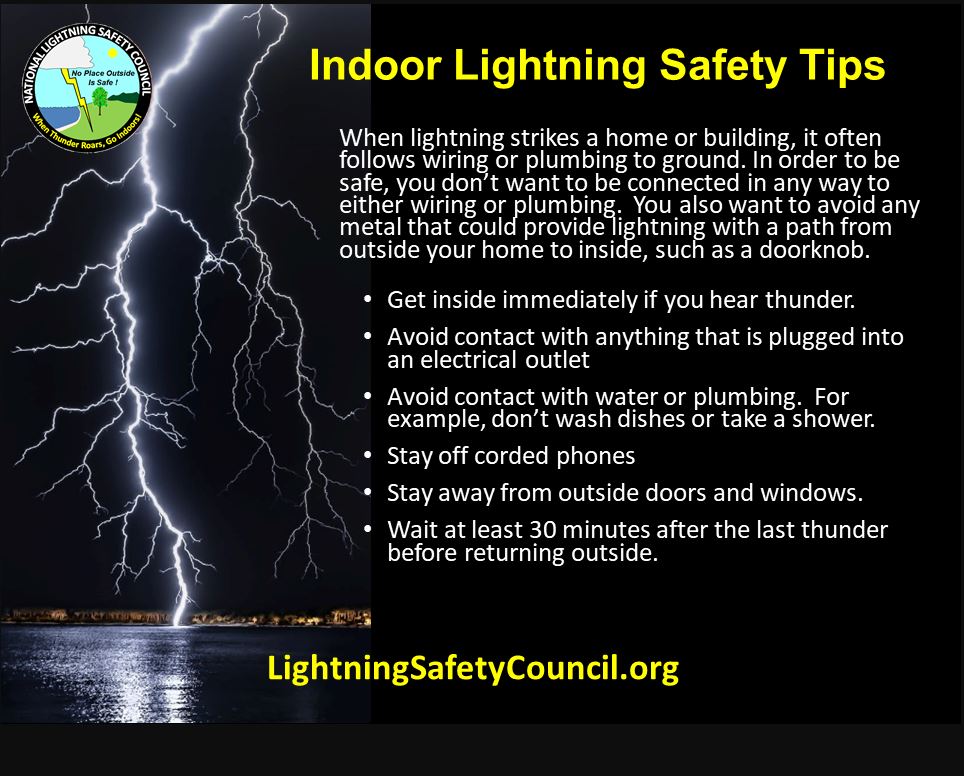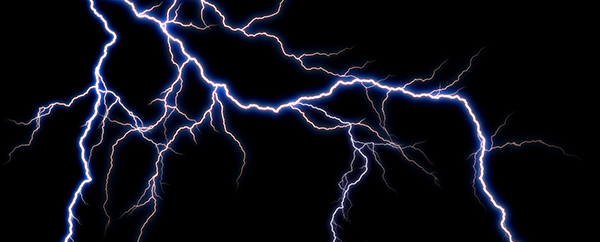What you need to know about lightning injuries and damage
- Lightning can strike up to 10 miles from a thunderstorm – about the distance that you can hear thunder from a storm. That means if you can hear thunder, you’re likely within striking distance.
- In the U.S., two-thirds of the area burned by wildfires is caused by lightning.
- Learn safety tips to avoid a lightning threat, whether outdoors, indoors, or in your car.
It’s summer thunderstorm season for every state of the Union. For this reason, we’re focusing on the potential threat of lightning injuries and damage – and how you can mitigate them.
Every year there are about 25 million cloud-to-ground lightning flashes in the U.S. Each one of those flashes is a potential killer. In fact, in the past 10 years, lightning has claimed the lives of 300 people in the U.S. alone. Of those struck each year, approximately 30 are killed; the others suffer lifelong disabilities, says the Lightning Safety Council.
Here are a few more facts about lighting from the Lightning Safety Council and Zurich:
- Lightning can strike about 10 miles from a thunderstorm – about the distance that you can hear thunder from a storm. That means if you can hear thunder – even a distant rumble – you’re likely within striking distance.
- If the sky looks threatening, don’t wait for that first flash of lightning or thunder rumble. That first flash can be just as deadly as any other flash in the storm.
- In the U.S., two-thirds of the area burned by wildfires is caused by lightning. The Bootleg Fire in Oregon created its own weather, which included fire clouds capable of spawning lightning to further exacerbate the existing fires.
- Lightning can heat the air it passes through to 50,000 degrees Fahrenheit – five times hotter than the sun’s surface.
Lightning strikes and homeowners
These sizzling bolts caused lightning injuries and damage to the tune of nearly $1 billion in homeowners claims last year, according to I.I.I. There were 62,189 claims involving lightning in 2022, up from 60,851 in 2021.
Florida topped the list with 5,504 lightning claims, followed by Georgia, Texas, California and North Carolina. Although the national average cost per claim was $15,280, says Insurance Journal, California’s cost per claim was more than double, at $36,319.
Related: 8 tornado safety tips for homeowners and business owners
Outdoor safety tips to avoid the threat of lightning injuries and damage
The Lightning Safety Council provides these tips to follow when you’re outdoors:
- Plan ahead. Know where you’ll go for safety and how long it will take you to get there. A hard-topped metal vehicle is a safe place, but keep away from anything metal inside the vehicle.
- Listen to the forecast. Consider cancelling or postponing an outdoor activity if thunderstorms are forecast.
- Monitor the weather. Keep an eye on the sky and monitor conditions on your cell phone.
- Get to a safe place. If the sky looks threatening or you hear thunder, get inside immediately. Never ignore the signs of an approaching storm.
- Wait for the threat to pass. Wait at least 30 minutes after the last thunder before returning outside.

Infographic courtesy of Lightning Safety Council.
Indoor safety tips to avoid a lightning threat
When lightning strikes a home or building, it often follows wiring or plumbing to the ground. In order to be safe, you don’t want to be connected in any way to either wiring or plumbing. You also want to avoid any metal that might provide strikes with a path from outside your home to inside, such as metal doors, metal window frames or even a doorknob.
- When you hear thunder, go inside.
- Stay away from doors, windows and fireplaces.
- Don’t touch anything that’s plugged into an electrical outlet.
- Don’t take a shower or wash dishes – avoid any contact with plumbing or water.
- Don’t use your landline.
- Wait 30 minutes after the last thunder you hear, before going outdoors.
- Learn more from NOAA’s lightning safety brochure
How to protect your commercial property from lightning damage
First, a few more statistics from Zurich on how lightning damages commercial buildings:
- It can send electricity through metal plumbing pipes, electrical wires including landline phones, and metal reinforcements in concrete floors and walls.
- It damages exposed equipment on a rooftop or exterior work areas, as well as indoors.
- Complex electronic equipment and computer systems may have an increased exposure to lightning and associated lightning surges. For example, in North America, electronics are designed to use around 120 volts of electricity and can withstand up to 169 volts. A power surge from lightning contains millions of volts, capable of quick destruction.
Zurich provides these ways you can help protect your property and employees from lightning injuries and damage:
Most property losses can be dramatically reduced and possibly even eliminated by using proper lightning protection for structures. NFPA guidelines and its Code 780 for installing lightning protection systems are considered the national standard by the Lightning Protection Institute (LPI). These systems create a network of low-resistance paths to intercept lightning’s destructive electricity and direct it to the ground – without impacting the structure and its occupants.
LPI outlines five elements that need to be in place for an effective lightning protection system. Its “Lightning Protection Overview” includes more detailed information on each of these elements:
-
- Strike termination devices must be able to accept direct lightning attachment and strikes before the lightning can reach insulated building materials.
- Cable conductors direct the lightning current over and through construction, without damage, between the strike terminations at the top and the grounding electrode system at the bottom.
- Below-grade grounding electrode systems must be able to efficiently move the lightning to its ultimate destination, safely away from the structure and its contents.
- Bonding, i.e., the interconnection of the lightning protection system to other internal grounded metallic systems, must be able to prevent lightning to side flash internally — in other words, stop it from jumping to a lower object (e.g., an individual or another object in the building).
- Surge protection devices must be installed at every service entrance to stop lightning from infiltrating utility lines and transfer the energy into the ground.
Each of these five elements depends upon careful attention to placement, use of proper materials and other considerations. Installation by qualified professionals is crucial.
Also consider ways you could mitigate potential damage in these areas:
- Critical rooftop equipment
- Complex electronic equipment, with sufficient surge protection for all your systems
- Additional exposures, such as yard storage of flammable or combustible liquids in tanks and/or vehicles that could be set on fire. Keep these at least 100 yards from your building.
- Solar arrays or panels
- Tall equipment such as construction cranes
Pre-plan to mitigate lightning damage
Pre-planning should be developed long before storm season. Consider these tips from Zurich Resilience Solutions to create your business continuity plan:
- Develop and implement a written emergency response plan that includes crisis communication procedures and covers all possible scenarios for the specific facility. The plan should be reviewed regularly and any time significant onsite modifications are made. Include in the plan all defined duties and functions of various employees.
- Provide training for staff on evacuation, intervention and first aid, depending on the specific needs and means available.
- Conduct regular emergency and evacuation drills. Evaluate results and implement changes/corrective actions as needed.
- Establish a list of contacts for external responders (ambulance, fire department, police, hospitals, etc.); ensure all employees receive a copy.
- Establish a system to notify any affected employee or family member in the event an employee is involved in catastrophic event.
- Assess your business resiliency with a business impact analysis.
- Review shutdown and evacuation processes, including data backup and shipping records offsite.
- Limit yard storage and remove flammable items, vehicles and, especially, propane tanks from the property or move them at least 100 feet away from the building.
Resources:
Lightning damage to buildings: Addressing a severe weather risk
Lightning Safety
National Weather Service: Lightning Safety for you and your family
Lightning to Blame for $952M in Homeowners Claims in 2022
Lightning Caused $1.3 Billion in U.S. Homeowners Claim Payouts in 2021: Triple I
Lightning-related home insurance claims totaled $952M in 2022

